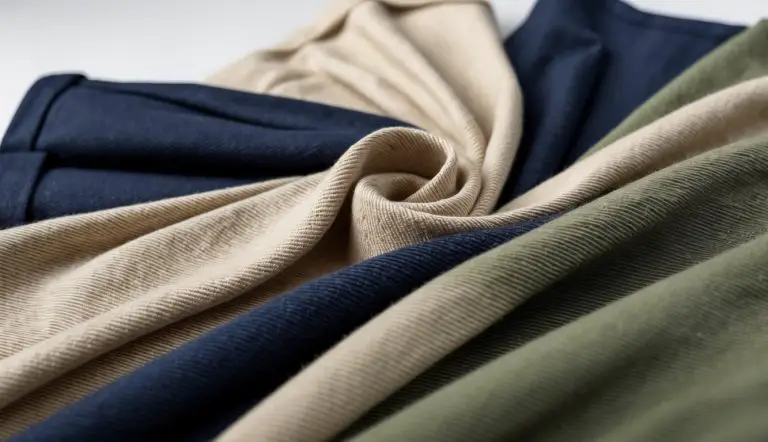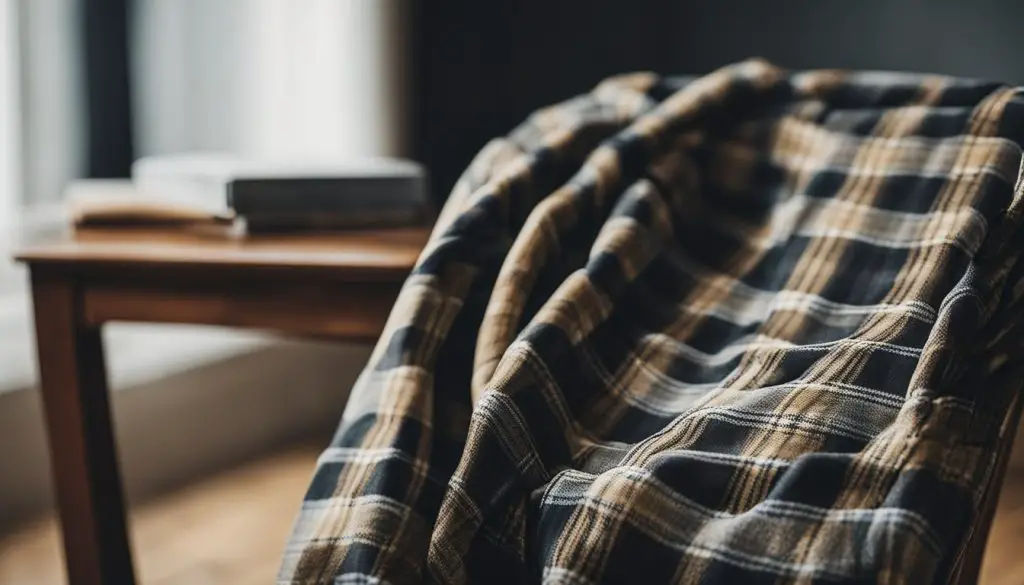Twill weave fabric often raises questions when warmer weather arrives. It’s known for its diagonal weave and durability, but that doesn’t always mean it feels light or airy. Twill can work for summer if it’s made from breathable fibers like cotton or linen.
The weave gives twill a smooth texture and helps it resist wrinkles, which makes it practical for daily wear. However, not all twill fabrics feel the same. Some are thick and heavy, while others are soft and lightweight, depending on the material and weave density.
Choosing the right type of twill can make a big difference in comfort. Lightweight cotton twill pants or shirts can keep someone cool while still looking polished, making them a smart choice for both casual and semi-formal summer outfits.
Key Takeaways
- Twill can be comfortable in summer when made from breathable materials.
- The fabric’s weight and weave affect how cool or warm it feels.
- Choosing lightweight cotton or linen twill offers comfort and style in hot weather.
Is Twill Good for Summer?
The popular Twill fabric offers durability and structure, but its comfort in hot weather depends on fiber type, weave density, and garment design. Cotton twill can feel breathable and soft, while polyester or blended twills may trap more heat.
Breathability and Comfort of Twill in Warm Weather
Twill’s diagonal weave creates a tight structure that affects airflow. Cotton twill allows moderate breathability, making it more comfortable than synthetic versions. However, it does not release heat as easily as open-weave fabrics like linen or lightweight poplin.
People often notice that twill feels heavier and warmer when the humidity is high. The weave traps some air, which can help in mild temperatures but may reduce ventilation in hot climates.
Comfort also depends on finish and thickness. A lightweight cotton twill shirt can feel soft and manageable, while thick denim twill pants may feel too warm for summer wear. Choosing thinner twill fabrics improves comfort and reduces heat buildup.
Weight and Texture Compared to Other Summer Fabrics
Twill fabric typically has a medium to heavy weight and a smooth, slightly raised texture. This makes it more structured than plain-weave fabrics. The diagonal lines add strength and drape but can increase warmth.
When compared to linen, twill feels denser and less airy. Linen’s loose weave lets more air pass through, keeping the body cooler. Twill’s tighter weave, while durable, holds more heat and moisture.
A simple comparison:
| Fabric Type | Breathability | Weight | Ideal Temperature |
|---|---|---|---|
| Cotton Twill | Moderate | Medium | Mild to warm |
| Linen | High | Light | Hot |
| Poplin | High | Light | Hot |
| Denim Twill | Low | Heavy | Cool to mild |
Lighter twills or blends with cotton can balance structure and comfort for moderate summer days.
Twill’s Suitability for Different Summer Activities
Twill works best for casual or semi-formal summer fabric for clothing that requires durability, such as chinos, light jackets, or workwear. Its strength resists wrinkles and wear, making it practical for travel or outdoor use.
For active or high-heat settings, twill may feel less comfortable than moisture-wicking or mesh textiles. It absorbs sweat but dries slowly, which can cause discomfort during long exposure to the sun.
In indoor or shaded environments, twill garments maintain a neat appearance and resist stretching. People often choose cotton twill pants or skirts for office wear in summer because they keep their shape and look polished without being overly stiff.
Types of Twill Fabrics for Summer
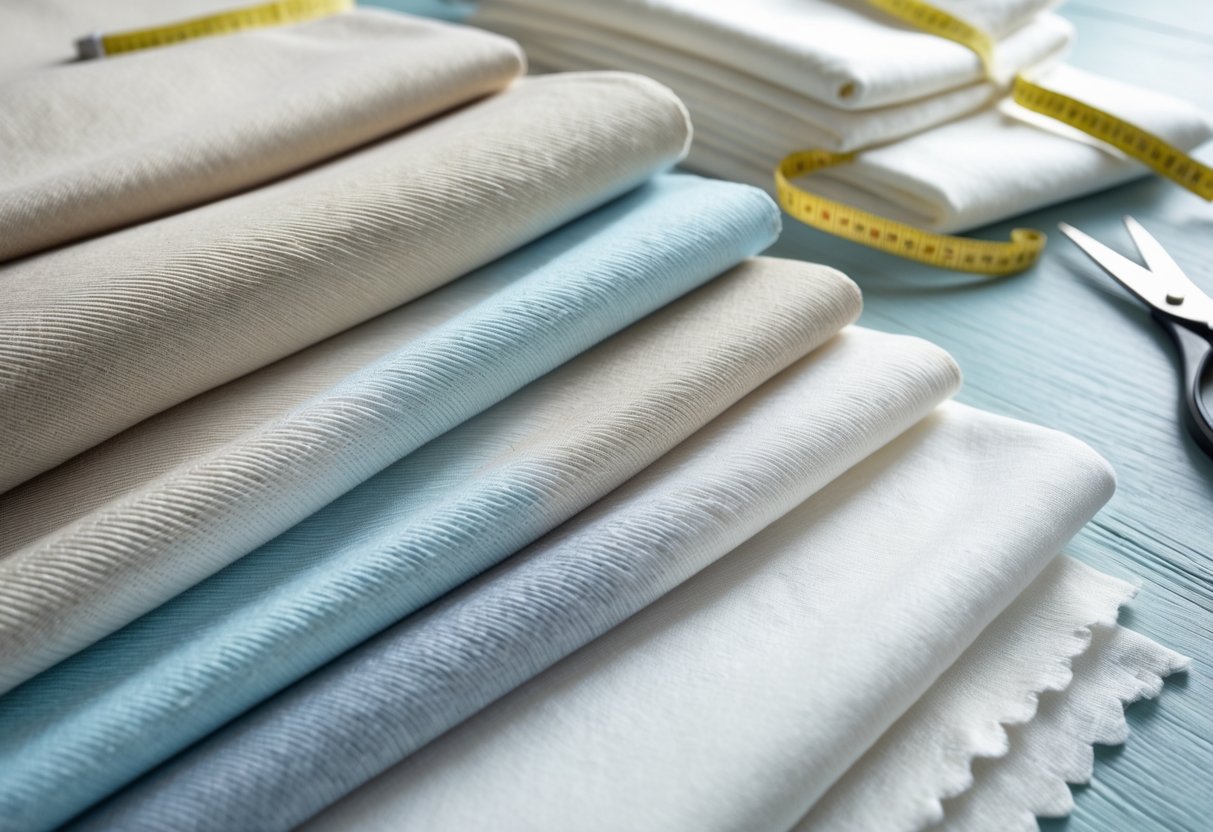
Different types of twill fabrics vary in breathability, weight, and texture. The choice of material affects how well clothing handles heat, moisture, and comfort during warm months.
Cotton Twill and Its Summer Benefits
Cotton twill uses natural cotton fibers woven in a diagonal pattern. This weave makes the fabric sturdy yet soft. It allows moderate airflow, which helps keep the body cool in warm weather.
Lightweight cotton twill works well for casual pants, shorts, and jackets. It resists wrinkles better than plain cotton and drapes smoothly, giving a neat look. The fabric also absorbs sweat, which is useful in humid conditions.
However, heavier cotton twill can trap heat. Choosing a lighter weave or pre-washed cotton twill improves comfort. The material’s durability and easy care make it a practical option for everyday summer wear.
| Property | Description |
|---|---|
| Fiber Type | 100% Natural Cotton |
| Breathability | Moderate to Good |
| Best Use | Pants, Shorts, Light Jackets |
| Care | Machine Washable |
Linen Twill for Hot Climates
Linen twill combines the coolness of linen with the structure of a twill weave. Linen, made from the flax plant, is a natural fiber known for its excellent moisture absorption and quick drying. This makes it ideal for very hot or humid climates.
Compared to plain-woven linen, linen twill feels smoother and less prone to wrinkling. It keeps its shape better, which helps clothing maintain a crisp look. The diagonal weave also adds a subtle texture that enhances breathability.
Because linen twill is lightweight and airy, it suits summer suits, shirts, and dresses. It may feel slightly coarse at first, but softens after washing. The fabric’s ability to stay cool even in direct sunlight makes it a strong choice for heat-prone regions.
| Property | Description |
|---|---|
| Fiber Type | 100% Natural Linen |
| Breathability | Excellent |
| Best Use | Suits, Shirts, Dresses |
| Care | Gentle Wash, Line Dry |
Blended Twill Fabrics: Natural and Synthetic Options
Blended twill fabrics mix natural fibers like cotton or linen with synthetic fibers such as polyester or nylon. These blends aim to balance comfort, durability, and wrinkle resistance. The synthetic content helps clothing hold shape and dry faster.
A cotton-polyester twill blend offers a cooler feel than full polyester but needs less ironing than pure cotton. It also resists shrinking and fading. Linen-rayon blends provide a smoother finish and softer drape while keeping much of linen’s breathability.
Blended twills are common in uniforms, chinos, and lightweight jackets. The exact comfort level depends on the fiber ratio. Higher natural fiber content improves airflow, while more synthetic fiber increases strength and reduces maintenance.
| Blend Type | Key Benefit | Ideal Use |
|---|---|---|
| Cotton-Polyester | Wrinkle Resistance | Chinos, Workwear |
| Linen-Rayon | Soft Drape | Shirts, Dresses |
| Cotton-Nylon | Durability | Jackets, Pants |
Twill Versus Other Popular Summer Fabrics
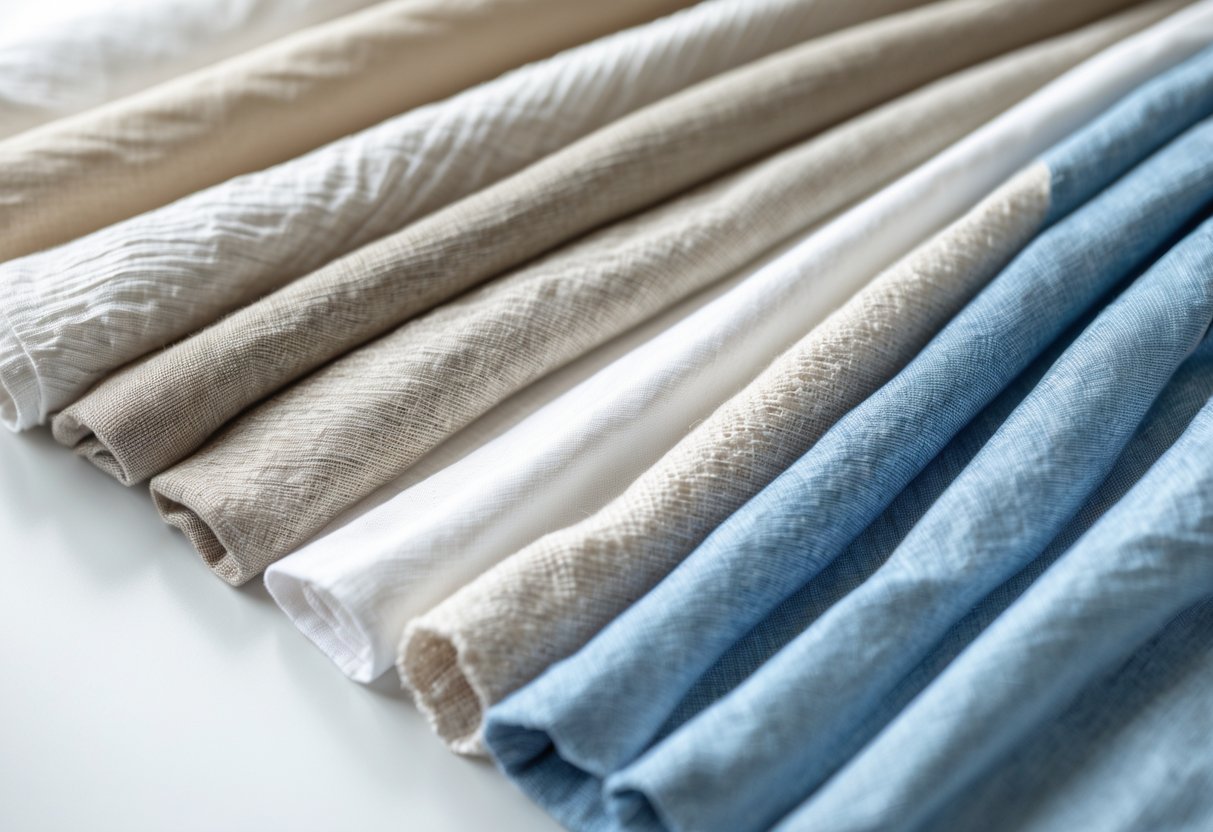
Twill offers strength and structure but varies in comfort compared to lighter materials. Its weave affects airflow, moisture control, and flexibility, which makes it perform differently from cotton, linen, and jersey in warm weather.
Twill vs. Cotton: Breathability and Feel
Cotton and twill both come from cotton fibers, but their weaves set them apart. Cotton plain weaves let air flow easily, keeping the fabric cooler. Twill weaves, with their diagonal pattern, are denser and less breathable. This makes twill slightly warmer to wear in hot conditions.
Twill feels smoother and more structured, while plain cotton feels softer and lighter. People often choose cotton for T-shirts, blouses, and summer dresses because it absorbs sweat and dries faster. Twill fabrics, like chinos or denim, resist wrinkles better and hold their shape, but they may trap more heat.
When comparing durability, twill wins. It lasts longer and resists tearing, making it useful for clothing that needs structure. Cotton, however, offers more comfort for direct skin contact in humid weather.
| Feature | Cotton | Twill |
|---|---|---|
| Breathability | High | Moderate |
| Texture | Soft | Smooth, structured |
| Durability | Moderate | High |
| Heat Retention | Low | Medium |
Twill vs. Linen: Cooling Properties
Linen is known for its excellent airflow and moisture-wicking ability. It stays cool even in high temperatures. Twill, in contrast, has a tighter weave that limits ventilation. As a result, linen feels cooler and lighter on the skin.
Linen fibers are thicker and naturally textured, which helps air circulate. Twill’s smoother surface and heavier weight give it a more polished look, but can make it warmer. For hot, dry climates, linen performs better at keeping the body comfortable.
Twill works well when a crisp appearance is important, such as in lightweight trousers or jackets. Linen suits relaxed styles like shirts, dresses, and loose pants. While twill resists wrinkles more effectively, linen’s breathability makes it the cooler option for summer wear.
| Feature | Linen | Twill |
|---|---|---|
| Airflow | Very high | Moderate |
| Weight | Light | Medium-heavy |
| Wrinkle Resistance | Low | High |
| Cooling Ability | Excellent | Fair |
Twill vs. Jersey: Flexibility and Use Cases
Jersey fabric is soft, stretchy, and breathable, often made from cotton or blends. Its knit structure allows air to pass through easily, making it comfortable for casual summer wear. Twill, being woven, has little stretch and feels firmer.
Jersey suits, T-shirts, lightweight dresses, and activewear because they moves with the body. Twill, on the other hand, is used for pants, skirts, and structured shirts that need shape retention. The difference lies in flexibility—jersey adapts to movement, while twill holds form.
In terms of care, the jersey is easy to wash and quick to dry. Twill takes longer to dry but resists wrinkles better. For hot weather, jersey offers a cooler, softer feel, while twill provides a more polished, durable option.
| Feature | Jersey | Twill |
|---|---|---|
| Stretch | High | Low |
| Breathability | High | Moderate |
| Structure | Soft, flexible | Firm, stable |
| Best For | Casual wear | Structured garments |
Best Practices for Wearing Twill in Summer

Lightweight twill fabric can stay comfortable in warm weather when chosen, colored, and cared for correctly. The weave type, fabric weight, and maintenance all affect how well twill performs as summer clothing.
Choosing the Right Twill Weave and Weight
Twill comes in several types, such as cotton twill, denim, and gabardine. For hot weather, lighter cotton twill is best because it allows more airflow and feels softer on the skin. Heavy twills like denim trap heat and are less comfortable in high temperatures.
A fabric weight between 5–7 ounces per square yard usually works well for summer. It provides structure without feeling stiff or heavy. Loose or fine weaves also help air circulate, reducing sweat buildup.
Selection tips:
- Pick cotton or linen-blend twill for breathability.
- Avoid synthetic fibers that hold heat.
- Test flexibility by gently stretching the fabric; lighter twills should bend easily.
Choosing the right weave and weight ensures twill clothing stays cool and wearable during long summer days.
Color Selection for Heat Management
Color affects how much heat fabric absorbs. Light colors like beige, white, or pale blue reflect sunlight, keeping the surface cooler. Dark shades, such as black or navy, absorb heat and can make twill less comfortable outdoors.
When selecting summer clothing, choosing neutral or pastel tones helps maintain comfort. These colors also pair easily with other wardrobe pieces.
Color and heat reflection table:
| Color Type | Heat Absorption | Best Use |
|---|---|---|
| Light (white, tan, light gray) | Low | Hot, sunny days |
| Medium (olive, khaki) | Moderate | Warm but shaded areas |
| Dark (navy, black) | High | Cooler evenings |
Color choice is a simple but effective way to manage body temperature while wearing twill in warm weather.
Caring for Twill Garments in Hot Weather
Proper care keeps twill fabric light and breathable. Frequent washing removes sweat and oils that can make fabric feel heavy. Use cool water and mild detergent to protect fibers and prevent fading.
Drying twill in shade or indoors helps preserve color and prevents shrinkage. High heat from dryers can stiffen fibers and reduce comfort.
Care checklist:
- Wash gently and avoid bleach.
- Air dry instead of using high heat.
- Iron on low settings if needed.
Good maintenance extends the life of summer twill clothing and keeps it fresh, soft, and suitable for daily wear.
Frequently Asked Questions About Twill
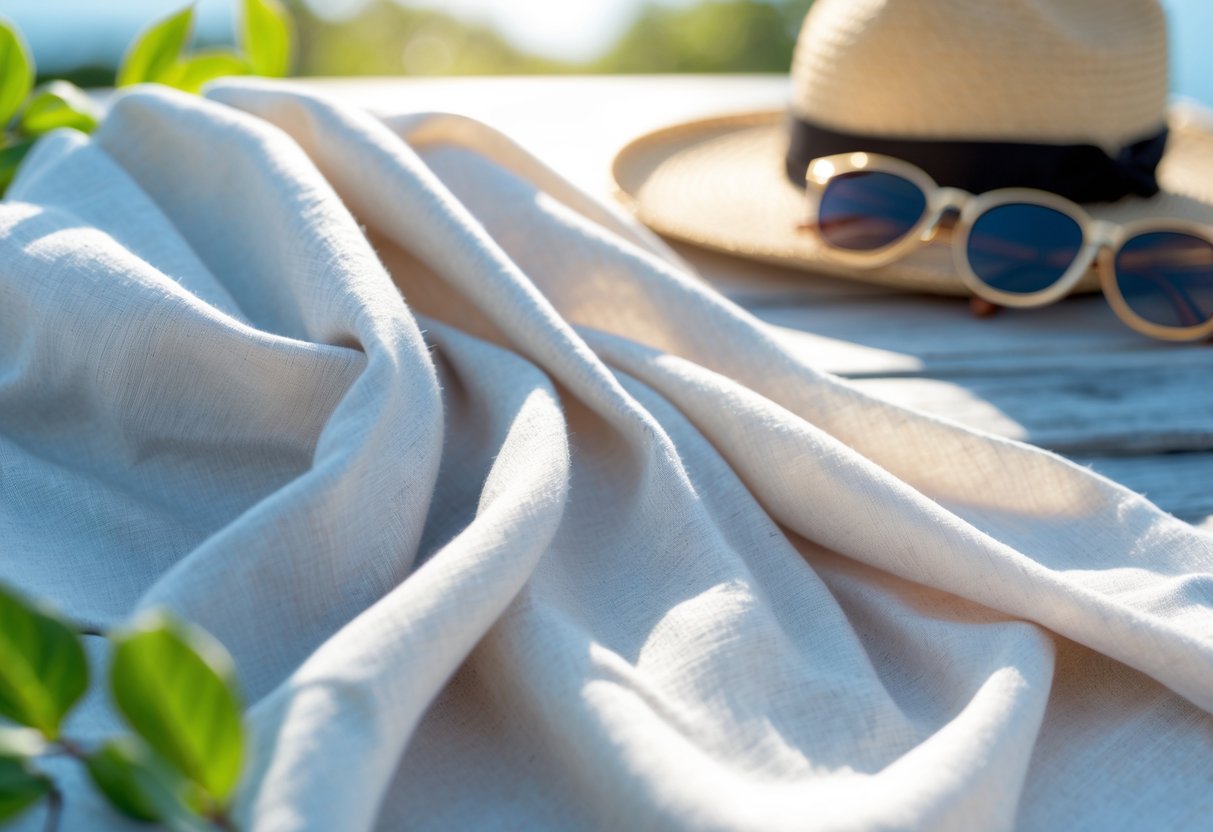
Twill fabric offers durability and a distinct weave that affects how it handles heat, moisture, and airflow. Its comfort level in warm weather depends on fiber type, weave density, and fabric weight.
What are the breathability characteristics of twill fabric for summer wear?
Twill fabric usually has a tighter weave than many lightweight summer fabrics. This limits airflow, making it less breathable. Cotton twill allows more air circulation than synthetic blends, which can trap heat and moisture.
How does twill compare to linen for summer clothing?
Linen is lighter and more breathable than twill. It absorbs moisture quickly and dries fast, helping the wearer stay cool. Twill, while sturdier, retains more heat and may feel heavier in hot weather.
Can twill fabric provide comfort in hot weather conditions?
Cotton twill can feel comfortable in mild summer temperatures. It absorbs sweat and feels soft on the skin. However, in very hot or humid conditions, it may feel warm because of its dense weave.
What are the potential drawbacks of using twill fabric in summer apparel?
The main drawbacks include limited breathability and a heavier weight. These factors can cause discomfort in high heat. Twill also tends to dry slowly compared to lighter fabrics like linen or chambray.
Are there any specific types of twill that are more suitable for summer?
Lightweight cotton twill and cotton-blend twills with added breathability work better for summer. Stretch twill or twill with moisture-wicking finishes can improve comfort in warmer conditions.
How does the weight of twill fabric affect its suitability for summer clothing?
Heavier twill traps more heat and restricts airflow, making it less suitable for hot weather. Lightweight twill allows better ventilation and feels cooler. Fabric labeled as “lightweight” or “summer twill” is best for warm climates.
